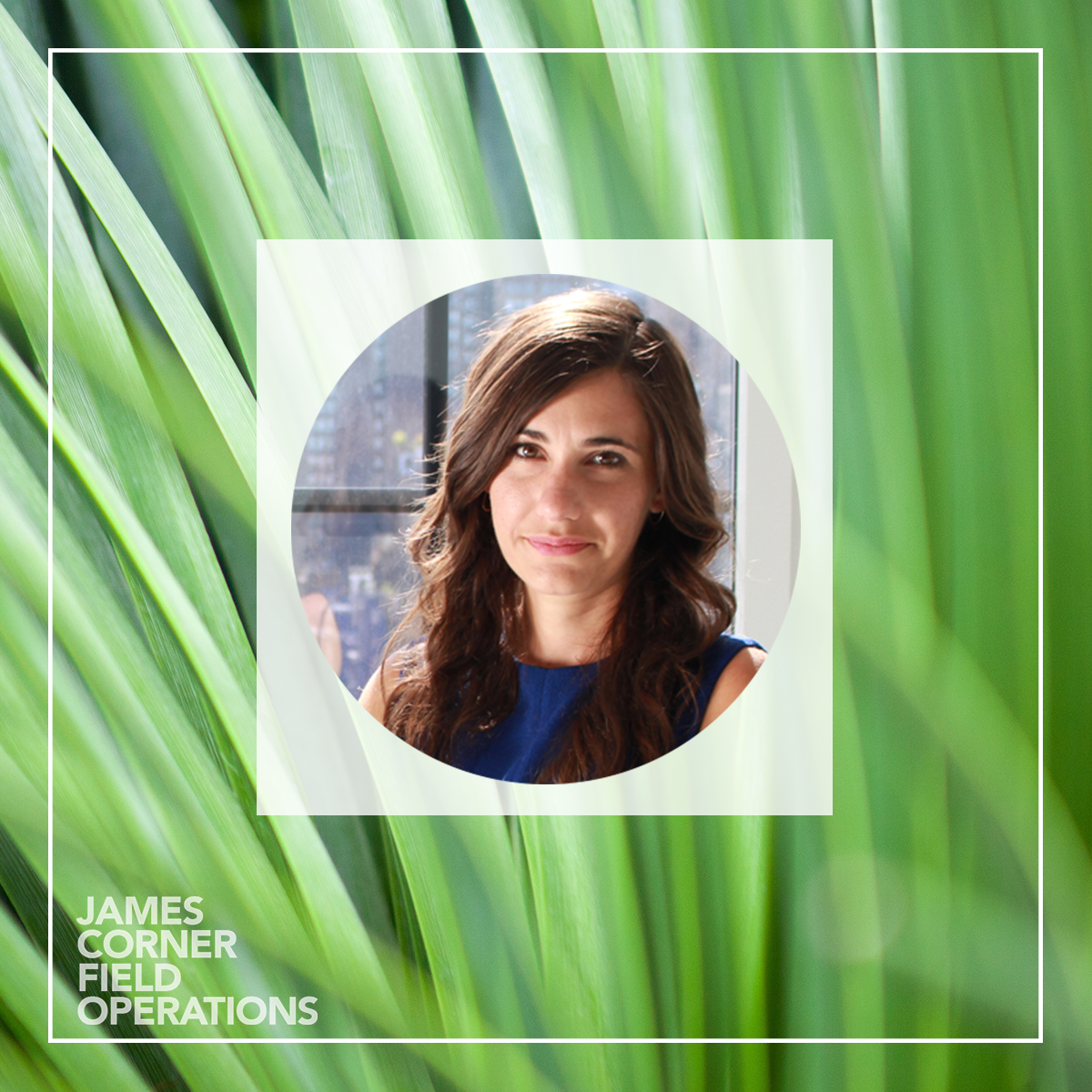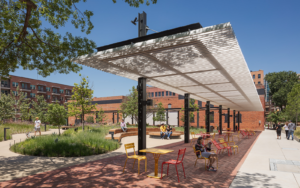Isabel Castilla is a principal designer at James Corner Field Operations, the landscape architecture firm designing West End Plaza, one of four new parks transforming Downtown Dallas. Isabel brings an impressive resume to this project. She’s currently the lead designer and project manager for both a section of the much-acclaimed High Line in New York City and The Underline, a linear park in Miami that, once completed, will stretch for 10 miles. Isabel also designed the ICEBERGS installation at the National Building Museum in Washington D.C., and her work has taken her as far as Puerto Rico and Australia.
Isabel recently paid a visit to Dallas, and we touched base with her to get her impressions of the West End Historic District, to learn which plaza design features she’s most excited about and to discuss how Dallas is leading the national movement to reclaim and revive urban public space.
You just spent a couple of days in Dallas. Tell us about your experience.
I’ve been really impressed with the way Downtown Dallas is developing and the level of importance the city is placing on open spaces. In my view, these open spaces are very developed and cutting-edge for such a young city.
In particular, I was really impressed by Klyde Warren Park and the variety of programs that it offers. Klyde Warren made me extremely enthusiastic about West End Plaza and the possibility that we will be working with a client who isn’t afraid of public spaces. Overall, my first impression of Dallas has been, “Wow, this is a great city that’s willing to take risks, and those risks have been very well-received.”
What drew James Corner Field Operations to West End Plaza? What makes this project unique?
One of the things that really interested me in the West End Plaza project was the opportunity to create a new public space in a historic district that has its own very particular character. The West End is very different from the rest of Downtown Dallas and what you would associate with Dallas as a whole. Yet there’s the initiative and vision to make this into a “smart” park.
How do you actually balance those two ideas — of something that’s very historic and needs to be respected and a space that is cutting-edge? That question is extremely interesting to me.
What are your thoughts on making more room for quality green spaces within Downtown Dallas?
I think it’s super-important. As more people move into Downtown, they’re giving up a suburban lifestyle for a denser type of living. And with denser living comes smaller apartments and enjoying the outdoors in a social capacity. You may want to go out and read a book under the shade of a tree, but, instead of laying in a hammock in your private backyard, you’re surrounded by other people.
As Downtown Dallas revitalizes, it’s critical that the city add more green spaces so that it can achieve a good balance of built and natural environments. In the end, humans have a craving for green space that needs to be satisfied frequently, even daily. So it’s very important that, as cities support density, supply public transportation and do all of the other great things that they do, they also provide a space of respite.
How do you see West End Plaza changing the way people experience Downtown Dallas?
When I first approached the project, I read a lot of tourist guides that portrayed the West End as this unique space known for its trees and brickwork. It was characterized as this very shady, cool space. But, as we explored it further, we actually found the space to be quite “hard.” There are great, beautiful, large trees, but they don’t really contribute that much to the overall greenery of the city.
When the opportunity to create the plaza came about, the first thing we endeavored to do was develop a scheme that was very green. We gravitated toward the idea of very lush gardens surrounded by buildings. We want the plaza to be this long, green space within the overall urban massing of the West End.
How do you see all four of Downtown Dallas Parks Conservancy’ projects affecting the city’s urban core in the next five years?
I think the parks will encourage an urban lifestyle that benefits both from population density and the ability to do more outdoors because of plentiful park space. These parks will become part of day-to-day life, whether by giving residents a place to exercise, a place to gather with friends or a weekend destination and place to get involved in some of the many activities Downtown Dallas, Inc. is planning.
I think the mentality of Dallasites is starting to change, and that’s really important. As cities grow, you want to minimize urban sprawl and really encourage people to live downtown, use public transportation and see the parks as both an extension of their own private space and a common area in which to connect with their community. The more parks a city builds, the more they become part of a larger network that supports healthy, urban living.
What’s your favorite amenity or design feature you’ll be implementing at West End Plaza?
The plans include a canopy that will surround the site, providing shade, tables and fans. I imagine it as an outdoor living room, and I can see people spending all day there, meeting new people and enjoying the outdoors. I could even see people bringing their work there, almost as if it were a coffee shop. At the same time, though, it’s still a park that has space for families. I’m very excited at the thought of what that canopy can accomplish and how it can help the city reimagine the nature of its public spaces.
Are there any fun facts the general public may not already know about the location that you’d like to share with us?
What I find very interesting is that the character of the historic buildings, the historic signs of the original manufacturing shops, are still present and they’ve been embraced by the area as a part of its identity. It’s really interesting to develop a new design within that context, and it’s been fun to learn about the history of each building and how its former identity has the potential to influence and inspire the park.
What are your favorite parks?
Brooklyn Bridge Park — I lived next to it before it was a park, and I saw it being built over a period of 10 years. It’s a beautiful park in the sense that it activates the Brooklyn waterfront, which used to be all industrial, and it has great views of the Manhattan skyline. But the park itself tries to be very natural in its design and uses very simple materials. It’s mostly about the views and feeling connected to the water.
I just moved to an area by Prospect Park, and I’m learning to really love it, too. Sometimes you really get lost in its trails and you feel like you’re hiking in the woods — you totally forget you’re in Brooklyn. I love that the original designers of Prospect Park in the 19th Century had a vision and understood that, within a dense urban context, you need an escape. Greenery and recreation make city life more livable. I’ve really come to appreciate Prospect Park. It serves as a model for what we’re trying to do in Dallas and at many of our other sites.
What’s one city you think is “doing it right” with its downtown revitalization efforts?
I’m not sure I’d name any specific city. I think many cities around the U.S. are placing more value on open spaces and transforming infrastructural spaces into great public amenities. Over the past few years, New York City has built a lot and really prioritized the waterfront to be an open public space, which is great.
I’ve been working a lot in Miami in recent years, too, and they’re also placing a lot of value on recreational trails that can connect the city and encourage people to bike, run and walk. I think overall the U.S. is moving in a very good direction where a lot of cities are investing in public spaces and attracting people downtown. We’re working to reduce urban sprawl and offset denser development through reinvestments in public space.
Of course, European cities have a great tradition of maintaining beautiful and functional public spaces. I think the U.S. is really stepping up to get closer to that European model, one that many landscape architects admire.
How do you think Dallas will compare to other cities once these four new Downtown parks are built?
I think Dallas is already at the forefront. Dallas is making such a large investment in public spaces, and it’s upped that investment in a very short period of time. It’s a rapid but well-balanced development. You’re developing Downtown as well as areas like Victory Park, but with the balance of open parks and trails. Balance is crucial, and in a few years, once these parks are built, I’m sure Dallas is going to make headlines as a city that really prioritizes public space.
With a rich history of preserving an area’s natural character while tying in smart-park design features, James Corner Field Operations continues to create innovative public spaces that offer a departure from the gray, concrete conventions of most urban design. To stay up-to-date on the progress the firm continues to make at West End Plaza, be sure to follow Downtown Dallas Parks Conservancy on Facebook, Instagram and Twitter.




